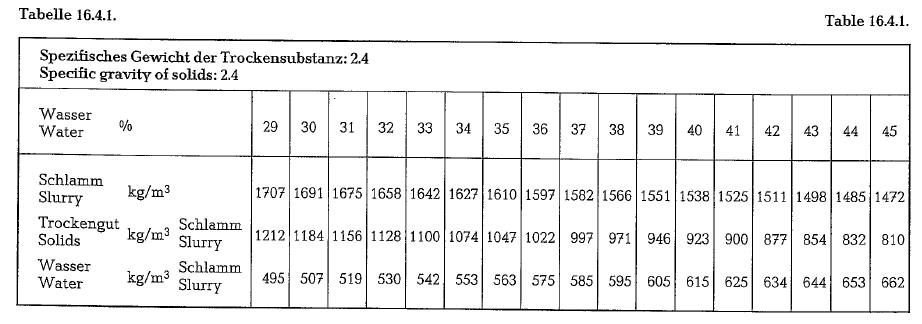Contents
Wet grinding in closed circuit
Closed circuit slurry grinding systems applying vibrating screens and wet cyclones as classifiers have been in use in the cement industry for some time.
IF YOU LIKE OUR POSTS AND WANT TO DOWNLOAD ALL OF THEM OFFLINE & IF YOU ARE INTERESTED IN DOWNLOADING THE MOST IMPORTANT BOOKS IN CEMENT INDUSTRY + ALL THE FORMULAS AND EQUATIONS AND CALCULATIONS SHEETS CLICK HERE TO DOWNLOAD THEM
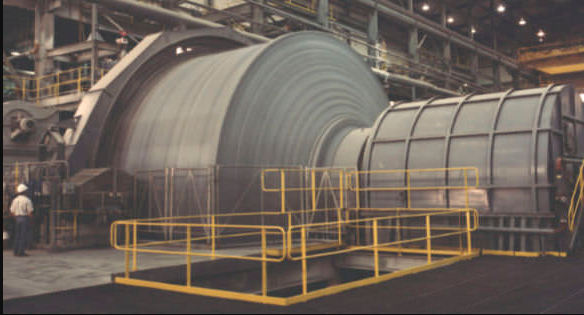
A relatively new classifier for closed circuit slurry grinding is the DSM Screen [162], an original develop ment of the Dutch State Mines, Limburg, The Nether lands, for use in their coal washeries.
The DSM Screen operates by passing the slurry to be classified at high speed across the surface of steel screen bars. The inside of the curved screen is the working surface. The apertures of the steel bars for coarse grinding are spaced 2 mm. Because of the velocity of the slurry the maximum particle size pass ing the aperture of 2 mm is only 1 mm in diameter. Due to this phenomenon, tendency toward screen blinding is nil and very rapid operation occurs; the result is high screen capacity. The screening surface consists of three goo segments, each 800 mm long.
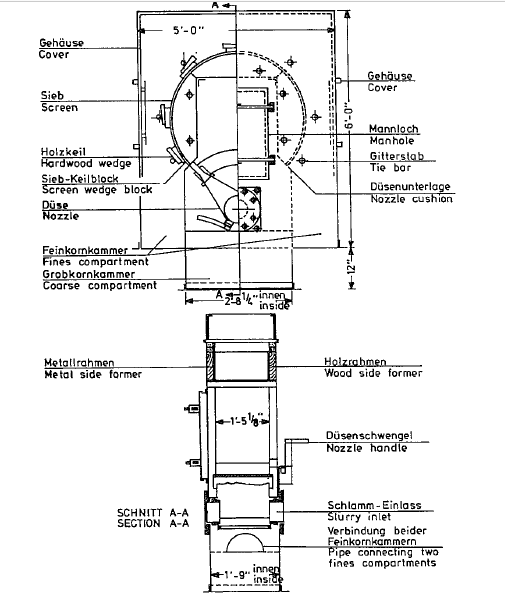
Fig. 16.1. Schematic view of the DSM Screen
For the fine separations required for cement slurry a 270° screen with apertures 0.3 or 0.8 mm wide is generally used. A schematic arrangement of the Dorr-Oliver 270° DSM Screen is shown in Fig. 16.1.
The stream of slurry emerging from a nozzle under pump pressure travels the full 270°. Due to the cen trifugal force the product of fines flows through the screen, while the slurry coarses complete the circle to a tailing launder. The fines are collected in com partments on both sides of the screen. The DSM Screen operation is schematically shown in Fig. 16.2.
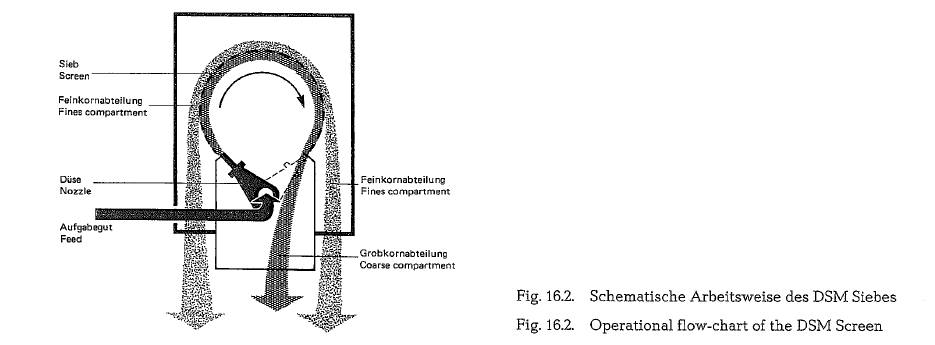
With the DSM Screen, separations can be made at sizes and water content which are impossible with comparable areas of screen in normal screening practice.
The DSM Screen surface is enclosed in a housing. The slurry nozzle can be reversed to equalize screen wear.
Screen size: For separations in the 100-150 mesh range and capacities of 55- 60 t/h (weight of dry material), the size of the screen ist 107 em in diameter (270° segment) and 51 em wide, providing an effective
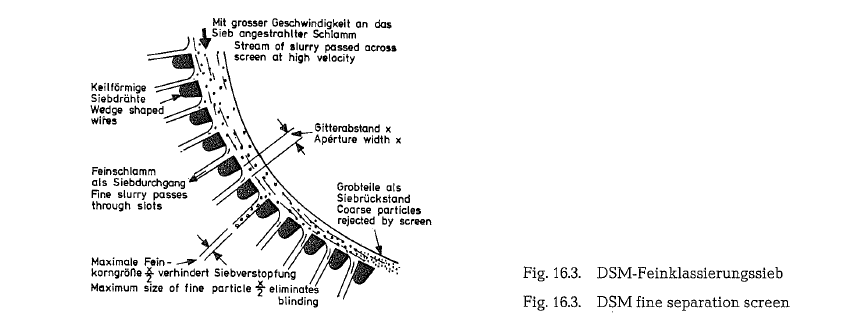
screening area of 1.28 m2. Fig. 16.3. shows a cross sec tion through the screen wires and illustrates the screen’s effectiveness for fine separation.
Examples of DSM-Screen performance
Example 16.1.
A tube mill operating in open circuit with an output of 41.5 t/h (dry substance), was connected to a DSM Screen for grinding in closed circuit. The increase in mill capacity was 59 t/h, thus 40 %. Mill power con sumption was the same as in open circuit grinding; the pump operation required an additional 40 HP.
Example 16.2.
Tube mill size 2.28 m x 11.55 m
one compartment mill; mill drive 820 HP
Material ground: Limestone with free silica and clay.
Power drawn by pump feeding DSM Screen: 25 HP
Nozzles: Split nozzle totalling 1.59 x 20.3 em, i.e. 32.3 cm2;
nozzle pressure: 1.40-1.75 kg/cm2
Screen: 0.3 mm aperture.
Output: Open circuit, 41.5 t/h
Closed circuit, 63.7 t/h (dry substance) Increase: 53 percent
Example 16.3.
Mill size: 2.12 x 12.16 m;
mill drive 750 HP; two compartment mill.
Material ground: Hard crystalline limestone and clay.
Power drawn by pump feeding DSM Screen: 50 HP. Nozzle: 1.42 x 33 em, i.e. 47 cm2
Nozzle pressure: 1.75 kg/cm2 Screen: 0.3 mm aperture
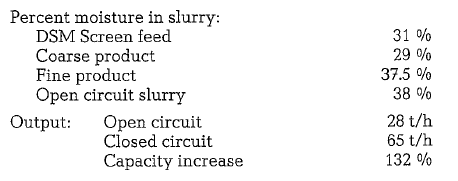
The DSM Screen consumes no power directly, but additional horsepower is required to pump the slurry. Any slurry which can be pumped, will classify satisfactorily. Circulating loads vary from 100 to 200 %, depending on mill performance as well as on other related factors.
Grinding flow chart with DSM-Screen
Fig. 16.4. shows a flow chart of a closed circuit slurry grinding arrangement, with tube mill. DSM Screen, oversize particle elevator, and pumps.
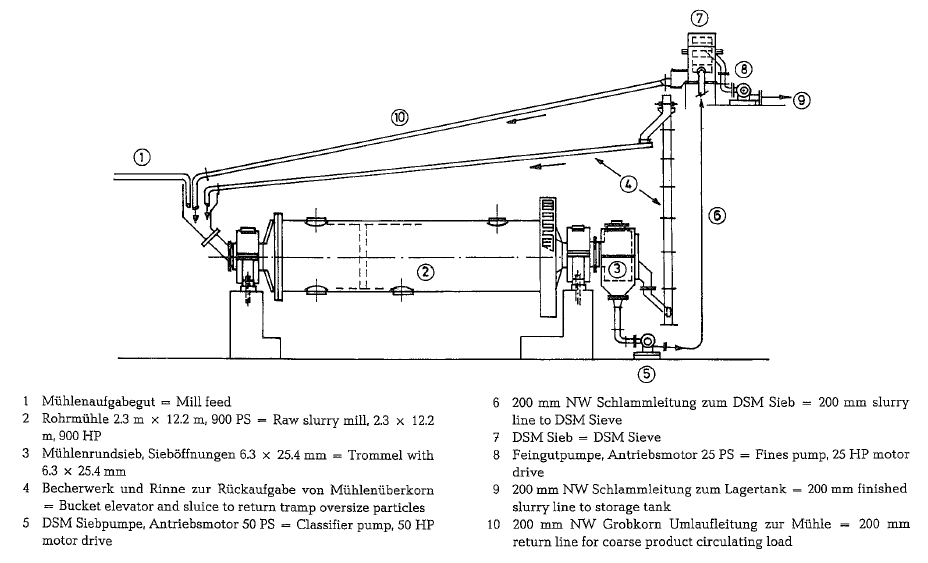
Fig. 16.4. Grinding flow-chart with DSM Screen
DSM-Screen operations
According to Dorr-Oliver, Inc., a survey covering 12 cement plants which installed DSM Screens for closed circuit grinding showed an overall capacity increase of 29.3 % compared to open circuit. The average reduction in plus 50 mesh material was 71 %.
As to screen maintenance the average cost per ton of cement is:

Labor is estimated at 0.31 cents per ton for a total screen maintenance figure of 3.22 cents per ton of cement.
The screen feed pump averages 1.55 HPh/t. The mill connected HP in open circuit averages 19.3 HPh/t. In closed circuit with screens it is 14.9 HPh/t, or a saving of 4.40 HPh/t. The net saving is 4.40- 1.55 = 2.85 HPh/t, or 2.13 kWh/t. At 4.5 cents per kWh this results in a net power saving of 9.6 cents/t. The screen maintenance is 3.22 cents as above. Therefore the net saving for the 270° DSM closed circuit system is 6.38 cents/t of cement. More important than the net saving is the reduction in plus 50 mesh material in the product. The reduction of oversize material to the kiln reduces the number of unburnt cores in the clinker. Some plants report an increased kiln output of almost 30 % with the same grinding equipment. At the present time 160 DSM Screens have been sold to the cement industry in the United States [163].
Cement slurry
Weights and volumes for water contents from 29-45 %. Metric units (see table 16.4.1.):
